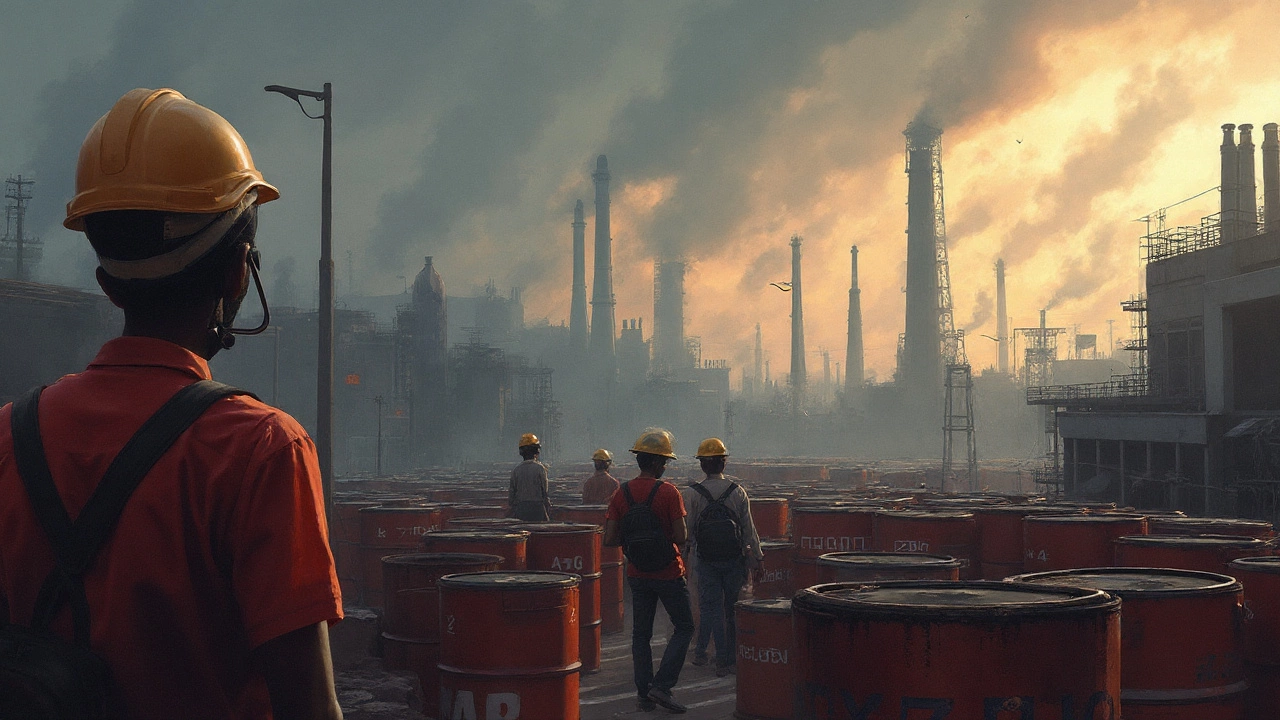When you think about India’s growth in 2025, chemistry probably isn’t the first thing that pops into your head. But there’s a good reason it should be: chemicals are the hidden backbone of everything, from smartphones to medicines to the cars we drive. Right now, things are tense. Supply chains are still wobbly from last year’s global hiccups. And India is facing a crunch with several high-demand chemicals. Companies are scrambling, prices are unpredictable, and some industries are in outright panic mode. Forget vague headlines—let’s break down what’s missing, why it’s a big deal, and what’s next.
Which Chemicals Are Running Low? The Hard Data for 2025
Every crisis needs specifics. So, what chemicals are actually hard to find in India right now? You’re looking at a laundry list, but three lead the pack: acetic acid, butadiene, and methanol. Acetic acid, used in everything from vinegar to adhesives, saw a 28% drop in domestic availability this year. Butadiene—critical for making tyres and rubber—has faced an import dip of nearly 34%. Methanol, the heart of paints, resins, and even fuels, is lagging by more than 13% compared to 2024. Caustic soda and soda ash have also landed on the shortage radar, impacting basic industries like textiles and glass.
Why these specifically? Method of production plays a huge role—most of these are oil-based or require heavy investment in large refineries. If global oil prices jump or local plants experience downtime, the entire supply chain feels it almost instantly. For example, many methanol plants in southern Asia halted operations due to soaring energy costs, which put even more pressure on India to import what it could.
Plasticizers, ethylene oxide, and specialty chemicals like certain dyes and pigments have also been hard to source reliably. Want the numbers? Here’s a neat snapshot.
| Chemical | Drop in Availability (2025 vs. 2024) | Key Affected Industries |
|---|---|---|
| Acetic Acid | 28% | Textiles, Pharma, Food Processing |
| Butadiene | 34% | Automobile, Tyre, Synthetic Rubber |
| Methanol | 13% | Paints, Resins, Alternative Fuels |
| Caustic Soda | 11% | Textile, Paper, Soap, Detergents |
| Soda Ash | 17% | Glass, Detergents, Chemicals |
And it’s not only about imports. One chemical might be in short supply in North India but easy to find in Mumbai’s ports. Distribution matters just as much.
Why Are Shortages Happening? Digging into the Causes
How did we get here? It’s a classic domino effect. You might blame the Russia-Ukraine crisis for messing up oil and gas flows, or maybe China’s recent environmental crackdowns that closed several old chemical plants. Both are right—and both play a big part. India imports a big chunk of its raw chemical feedstock, especially for stuff like methanol and butadiene. If shipments even slow down a bit, immediate shortages begin, especially with warehouses running leaner than ever to save on costs.
But there’s more. Several refineries and plants in India pushed back maintenance in 2024 hoping for more stable demand. That plan backfired—when they all went down for annual repair cycles in the first half of 2025, replacement imports couldn’t arrive fast enough to fill the gap. Toss in a couple of tough monsoon months and delayed cargo ships, and you’re looking at gaps lasting weeks or even months in some cases.
Another quiet troublemaker is logistics. The new GST regime simplified paperwork, but many smaller chemical transporters folded due to high fuel costs and compliance headaches. Chemicals need careful, specialized handling; you can’t just swap a drum of caustic soda in any truck. The dominoes fell fast when a handful of players dropped out.
The last issue? Some chemicals aren’t lucrative enough for big Indian firms to bother making at scale, especially when margins are razor-thin. Take soda ash—why set up expensive new plants when imports used to be dirt cheap? But when China closed the tap on exports to save their own stocks, Indian manufacturers were caught flat-footed.

The Big Impact: Industries & Everyday Life Take a Hit
Who actually feels all this? Honestly, everyone—directly or indirectly. The tyre industry is a classic example. With less butadiene, rubber prices shot up 23% since January. That adds about ₹475 to the price of a basic car tyre as of August 2025. Car companies delayed launches and some had to cut shifts.
Textile firms are sweating too. Acetic acid is key for finishing fabrics and making certain synthetic fibers. When supply tanks, even dyeing operations grind to a halt. Apparel exports from Gujarat dipped 13% last quarter, and some factories have switched to overtime just to meet ongoing orders before raw materials run out.
Food and beverage manufacturers? You better believe they’re watching the acetic acid market like hawks. It’s a backbone for making vinegar, additives, and flavor enhancers. A bottling plant in Haryana paid nearly double to source acetic acid locally and still had to halt lines for two weeks because deliveries didn’t come on time.
And then there’s pharma. Many medicines, like simple fever reducers and even antibiotics, rely on chemicals like caustic soda as part of their multi-step process. Big pharma giants have managed OK due to advance contracts, but dozens of smaller units faced production stops—meaning some drugs were briefly out of stock in smaller cities this past spring.
Even common stuff—like soaps and detergents—got pricier. Most users probably didn’t see a dramatic spike unless they were buying in bulk, but manufacturers sure noticed. Higher input costs have quietly trimmed profit margins across the board. That trickles down into fewer discounts and tighter supplies, especially for small retail shops.
One strange side effect: a spike in demand for used chemical drums and containers. With new ones delayed, local recyclers are making a killing, selling refurbished containers at triple last year’s rates.
How Can Companies and Buyers Adapt? Tips and Real-World Moves
If you’re running a business—or even just thinking about how this chemical shortage mess affects your job—there’s a real need to get creative. Forget the idea of sitting and waiting things out. Top firms have started locking in longer-term supply contracts, even if prices are a little higher right now, just for peace of mind and to keep plants running. Others are actively searching for alternative suppliers, including smaller importers who used to be ignored when big shipments were flowing freely from the world’s biggest chemical exporters.
Some textile and food companies are shifting to alternative chemicals where possible. For example, a few beverage bottlers replaced synthetic vinegar made from acetic acid with natural apple cider vinegar for some local products. That’s not the cheapest route, but it keeps lines operational and customers happy when the chemical version can’t be found easily.
Pharma companies are doubling down on local vendor development programs. They’re working with smaller chemical makers in Maharashtra and Gujarat to upgrade quality systems, which lets them source critical chemicals domestically, even when big international players get shaky. Meanwhile, smart logistics managers are partnering directly with chemical tank operators, sometimes pooling shipments with friendly competitors just to save a few days on incoming supplies.
For everyone else, there are some general tricks:
- Watch industry news sites closely—chemical price swings can warn you when to bulk up on stock, even for simple things like cleaning supplies.
- If you’re in procurement, develop backups for your usual suppliers and check how much they actually hold on hand. Don’t assume promises mean real warehouse stock.
- Get friendly with logistics partners—they’re often the first to spot problems, and being on good terms means they’ll help you jump the queue when things get rough.
- Consider tweaking your formulations. If your process can allow for it, swapping out scarce chemicals for alternatives—even less ideal ones—can keep things moving.
- Don’t play the blame game; work with partners to share shortages and smooth over supply gaps—it’s easier to get flexibility if you’re cooperative, not combative.
Chemical shortages in India may sound like a distant, specialist problem, but the effects hit almost everything. The story isn’t just about numbers, but also about how industries stay nimble, how businesses have to change fast, and how a single missing shipment can send shockwaves through supply chains—sometimes right to your doorstep.
